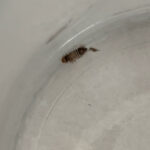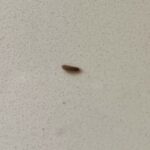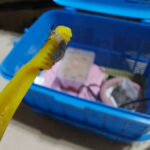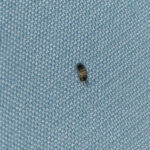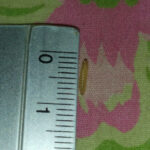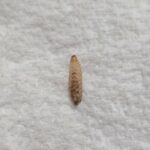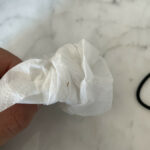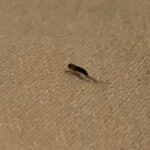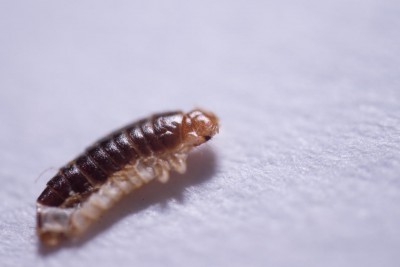
“What kind of worm (or whatever it is) is this?” asks this reader about the brown, segmented larva-looking creature his girlfriend found on their bed. This article will attempt to answer this question of the worm’s identity, or at the very least provide some ideas as to what it might be.
Firstly, we want to commend our reader for the excellent photograph he sent in; it looks like it was professionally taken! Not only does this help us identify the given organism’s particular physical characteristics, but it will make an excellent addition to our library. It is our opinion that this is an immature carpet beetle larvae. This identification is made based on the segmentation, the hard-look of the creature’s exoskeleton, the clear growth of prolegs, the coloration and the location in which the creature was found. We do want to clarify that it might be something else as well, but given its minuscule size and apparent underdevelopment, it is difficult to say with any degree of certainty what the creature is.
Now, provided the assumption that this is indeed a carpet beetle larva, we think it might be useful to lay out some basic facts about the larva so as to give our reader a heads up of what he might expect from such a creature. The carpet beetle larva, as cute as this one seems, is a notorious household pest that has caused many people trouble. They are not dangerous to humans or pets, but they will chew through materials that both humans and animals leave behind. To clarify, carpet beetle larvae will eat almost anything that is even partially animal-based in its production, save food items (though the adult beetle has been known to eat some food products that are not animal-based, oddly enough). These critters can go unnoticed for long periods of time as their neutral coloration often allows them to blend in with the carpets, hides and fur that they feed on. Of course, once they decide to journey across a white bed sheet (as seems to be the case for our reader), they become far easier to spot.
We recommend that our reader search his home for signs of more carpet beetle larvae, as infestations are possible (especially given that they can take a while to discover). Places he might want to look include: under and around the bed this larva was found, underneath and behind upholstered furniture, places where any pets he may have often spend time, any places where clothes are stored (especially ones that go unused for long periods of time), and, of course, carpets. So as not to provide a long-winded answer to our reader’s simple question, we will point our reader to a comprehensive article on carpet beetles written and provided by Jarrod Warkentin, who featured on AllAboutWorms recently with this text (thank you!).
To conclude, the worm-like creature our reader’s girlfriend found on her bed is likely an underdeveloped carpet beetle larva, though we are leaving this up for debate. If our reader does find more of these critters, especially ones that are more mature, he is welcome to send us more photos so that we can confirm or deny this identification.
All About Worms is always free, always reader-supported. Your tips via CashApp, Venmo, or Paypal are appreciated! Receipts will come from ISIPP Publishing.
You might also find these guys interesting!





